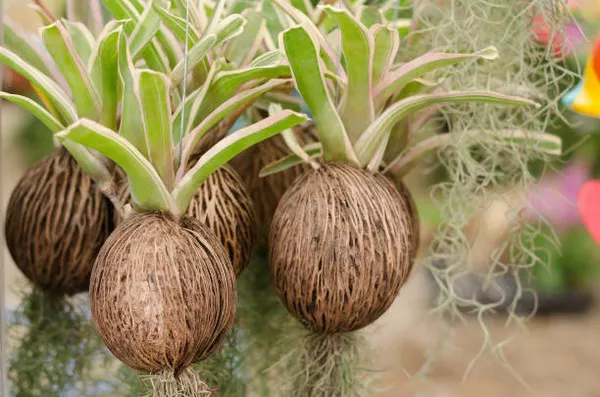Air plants, also known as Tillandsia, have captured the fascination of plant enthusiasts and interior designers alike for their unique ability to thrive without soil. These extraordinary plants are not only visually appealing but also intriguing in their mechanism of obtaining nutrients and water. This article delves into the fascinating world of air plants, shedding light on how they work, their growth requirements, and tips for cultivating and caring for these captivating botanical wonders.
Understanding Air Plants
Air plants belong to the Bromeliaceae family, and they are native to the forests, deserts, and mountains of Central and South America. There are over 650 species of Tillandsia, each with its own distinctive characteristics, making them a diverse and visually appealing group of plants.
Key Characteristics of Air Plants
Epiphytic Nature: Air plants are epiphytes, which means they naturally grow on other surfaces such as trees, rocks, and buildings, without harming the host. They do not rely on soil for anchorage or nutrients, making them uniquely adapted to survive in diverse environments.
Trichomes: The most remarkable feature of air plants is their trichomes. These tiny hair-like structures cover the plant’s surface and play a crucial role in nutrient and water absorption. Trichomes trap moisture and nutrients from the air, allowing air plants to grow and thrive.
How Do Air Plants Acquire Water?
Air plants have evolved several mechanisms to obtain water in their natural habitat. These mechanisms also make them highly adaptable for indoor cultivation:
Atmospheric Absorption: Air plants absorb moisture from the surrounding atmosphere through their trichomes. These specialized structures are designed to capture water droplets from rain, dew, and even high humidity levels. This moisture is then absorbed and stored within the plant’s cells.
Watering Techniques: When cultivating air plants at home, replicating their natural environment is essential. To water air plants, enthusiasts often mist them with water or soak them in a container filled with water for about 30 minutes. The plant absorbs the moisture through its trichomes, ensuring proper hydration.
Rainfall and Dew: In their native habitats, air plants rely on rainfall and dew for hydration. They have evolved to thrive in areas with regular precipitation, such as tropical rainforests, where they receive ample moisture.
How Do Air Plants Obtain Nutrients?
In addition to water, air plants require essential nutrients to thrive. While they do not rely on soil, they have developed various strategies to acquire the nutrients they need:
Atmospheric Nutrient Absorption: Just as they capture moisture from the air, air plants also absorb nutrients from the atmosphere. They assimilate minerals and nutrients, such as nitrogen and potassium, from dust, decaying plant matter, and airborne particles.
Nutrient-Rich Environments: Air plants often establish themselves in nutrient-rich microenvironments, such as tree branches covered in decaying leaves or bird droppings. These microenvironments provide an additional source of essential nutrients.
Complementary Care: In cultivation, air plants benefit from occasional nutrient supplementation. This can be achieved by misting them with a diluted, balanced, liquid fertilizer or by submerging them in a water-fertilizer solution every few weeks. However, it’s essential not to over-fertilize, as this can harm the plant.
Growing and Caring for Air Plants
Cultivating air plants can be a rewarding and visually appealing experience, provided that their specific requirements are met. Here are some essential care tips to help you succeed in growing and caring for air plants:
Light Requirements: Air plants thrive in bright, indirect light. They should be placed near a window with filtered sunlight or under artificial grow lights. Avoid exposing them to direct, intense sunlight, as it can lead to leaf burn.
Proper Air Circulation: Air plants require good air circulation to prevent rot and encourage trichome health. Ensure that your plants have adequate ventilation by placing them in an area with sufficient air movement.
Watering: Water your air plants as needed, typically once a week, but the frequency may vary depending on environmental conditions. Pay attention to the moisture level in your home and adjust your watering schedule accordingly.
Drying: After watering, it’s crucial to let the plants dry thoroughly to prevent rot. Place them upside down or in a way that allows excess water to drain out, and make sure they are fully dry before returning them to their display location.
Temperature Range: Air plants prefer a temperature range between 50°F (10°C) and 90°F (32°C). Avoid exposing them to extreme cold or heat, as it can harm the plants.
Avoiding Standing Water: Water should not accumulate in the plant’s central cup (the rosette of leaves), as this can cause rot. Shake off any excess water from the central cup after watering.
Fertilization: As mentioned earlier, air plants benefit from occasional fertilization. Use a balanced, water-soluble fertilizer, and apply it sparingly to avoid over-fertilization.
Conclusion
Air plants are remarkable botanical wonders that have evolved unique mechanisms for obtaining water and nutrients, allowing them to thrive in diverse environments. Their epiphytic nature, trichomes, and atmospheric absorption make them not only visually appealing but also relatively easy to cultivate indoors. By understanding their specific requirements and following proper care guidelines, you can enjoy the beauty and intrigue of air plants in your own home or office. Embracing these low-maintenance plants adds a touch of nature’s wonder to any space, making them a popular choice among plant enthusiasts and interior decorators alike.


